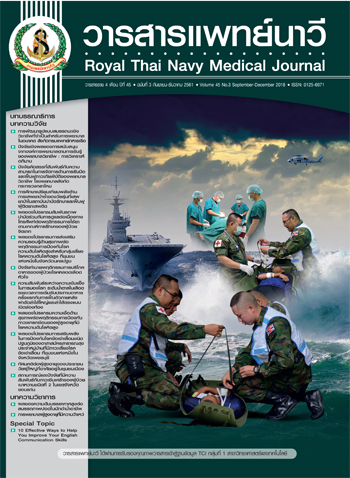Effect of Hyperbaric Environment on Pulmonary Function in Professional Divers
Main Article Content
Abstract
Diving may cause a number of adverse effects on health. Divers should strictly follow the rules to ensure their safety and avoid any possible adverse outcomes. The in-water hyperbaric environment directly affects partial pressure of the breathing gas, which results in changes of body systems, in particular respiratory system. Professional divers who work under hyperbaric conditions for a lengthy period may experience substantial effect to change their lung function. Pre-placement and periodic health examinations are essential to evaluate their readiness to work. Recent evidences about changes of lung function in Forced Vital Capacity (FVC) and Forced Expiratory Volume in 1st second (FEV1) are still inconclusive. Nevertheless, most studies demonstrate a slight depletion, 2% over 5 years, in FEV1/FVC ratio (FEV1%) which might suggest air trapping in divers’ lungs. Furthermore, maximum mid-expiratory flow (FEF25-75%) significantly decreases between 23 to 146 ml/year, which reflects possibility of small airway diseases in divers. The findings raise the concern of increasing risks of pulmonary barotrauma in divers.
Article Details

This work is licensed under a Creative Commons Attribution-NonCommercial-NoDerivatives 4.0 International License.
References
Health and Safety Executive. HSE and diving. [Internet]. [cited 2017 November 17]. Available from: http://www.hse.gov.uk/diving/index.htm.
Edmonds C, Bennett M, Lippmann J, Mitchell S. Diving and subaquatic medicine: CRC Press; 2015.
Moon RE, Cherry AD, Stolp BW, Camporesi EM. Pulmonary gas exchange in diving. J Appl Physiol 2009;106:668-77.
Tetzlaff K, Thomas PS. Short- and long-term effects of diving on pulmonary function. Eur Respir Rev Eur Respir Rev 2017 Mar 29;26(143).
Hostler D, Pendergast DR. Long-term diving-related lung damage: an editorial perspective. Undersea Hyperb Med 2016;43(6):629-31.
United States Navy (U.S. Navy). U.S. Navy diving manual, Revision 7. SS521-AG-PRO-010. Washington, D.C: U.S. Government Printing Office; 2016.
Moon RE, Martina SD, Peacher DF, Potter JF, Wester TE, Cherry AD, et al. Swimming-induced pulmonary edema: pathophysiology and risk reduction with sildenafil. Circulation 2016;133(10):988-96.
Pougnet R, Pougnet L, Lucas D, Uguen M, Henckes A, Dewitte JD, et al. Longitudinal change in professional divers' lung function: literature review. Int Marit Health 2014;65(4):223-9.
Lafere P, Germonpre P, Balestra C. Pulmonary barotrauma in divers during emergency free ascent training: review of 124 cases. Aviat Space Environ Med 2009;80(4):371-5.
Health and Safety Executive. The medical examination and assessment of commercial divers (MA1). [Internet]. [cited 2017 October 31]. Available from: http://www.ndc.nl/downloadables/ma1.pdf.
UK Sport Diving Medical Committee. Medical conditions. [Internet]. [cited 2017 October 31]. Available from: http://www.ukdmc.org/medical-conditions/.
ประกาศกรมสวัสดิการและคุ้มครองแรงงาน เรื่อง โรคที่ห้ามทํางานประดาน้ำ พ.ศ. 2553. (1 ตุลาคม 2553). ราชกิจจานุเบกษา. เล่ม 127 ตอนพิเศษ 115 ง. หน้า 36-7.
Comex SA. Centre d’Essais Hyperbares. 1965 - 2000; 36 years of deep diving and submarine techniques development. [Internet]. [cited 2017 November 18]. Available from: https://web.archive.org/web/20071013071223/http://www.comex.fr/suite/ceh/histo/historique%20CEH%20anglais.pdf.
Adir Y, Shupak A, Laor A, Weiler-Ravell D. Large lungs in divers: natural selection or a training effect? Chest 2005;128(1):224-8.
Skogstad M, Thorsen E, Haldorsen T. Lung function over the first 3 years of a professional diving career. Occup Environ Med 2000;57(6):390-5.
Konarski M, Klos R, Nitsch-Osuch A, Korzeniewski K, Prokop E. Lung function in divers. Adv Exp Med Biol 2013;788:221-7.
Chong SJ, Tan TW, Lim JY. Changes in lung function in Republic of Singapore Navy divers. Send to Diving Hyperb Med 2008;38(2):68-70.
Fitzpatrick DT, Conkin J. Improved pulmonary function in working divers breathing nitrox at shallow depths. Aviat Space Environ Med 2003;74(7):763-7.
Skogstad M, Thorsen E, Haldorsen T, Kjuus H. Lung function over six years among professional divers. Occup Environ Med 2002;59(9):629-33.
Watt SJ. Effect of commercial diving on ventilatory function. Br J Ind Med 1985;42(1):59-62.
Thorsen E, Segadal K, Kambestad BK, Gulsvik A. Pulmonary function one and four years after a deep saturation dive. Scand J Work Environ Health 1993;19(2):115-20.
Sames C, Gorman DF, Mitchell SJ, Gamble G. The long-term effects of compressed gas diving on lung function in New Zealand occupational divers: a retrospective analysis. Diving Hyperb Med 2009;39(3):133-7.
Skogstad M, Skare O. Pulmonary function among professional divers over 12 years and the effect of total number of dives. Aviat Space Environ Med 2008;79(9):883-7.
Davey IS, Cotes JE, Reed JW. Relationship of ventilatory capacity to hyperbaric exposure in divers. J Appl Physiol Respir Environ Exerc Physiol 1984;56(6):1655-8.


